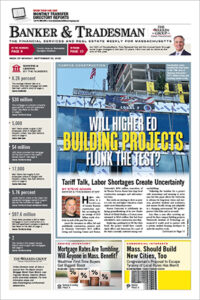Prominent economists across the real estate world are turning out their predictions for the new year, and some have New England markets in their lists of top performers for 2023.
But uncertainty over the economy’s direction has created an unusually broad spread among this season’s forecasts.
Economists at Zillow expect home values to remain “relatively flat” at the national level, while those at Freddie Mac expect a 0.2 percent drop in the nationwide median home-sale price and Fannie Mae’s analysts think a 1.5 percent drop is in the cards.
More pessimistic takes can reportedly be had from John Burns Real Estate Consulting (a 20 percent to 22 percent drop) and Wall Street firms like Moody’s Analytics (10 percent drop). Consultancy KPMG’s chief economist, Diane Swonk, recently wrote that she foresees a 20 percent drop in the CoreLogic Case-Shiller Home Price Index in the fourth quarter of 2023 over the fourth quarter of this year.
Optimistic takes can still be had, too: Realtor.com’s team thinks 2023 could see 5.4 percent home price growth on a year-over-year basis, and CoreLogic believes a 4.1 percent gain is possible.
The picture for numbers of sales – important for brokerage and agent cash flow after two years of easy profits – is clearer. Freddie Mac sees a roughly 12 percent decline nationwide while Realtor.com envisions a 14.1 percent slide; Fannie Mae sees a 17.7 percent drop-off and Redfin sees a 16 percent fall.
The key, many observers say, is what happens with mortgage rates. John Burns Real Estate Consulting’s forecast, for example, is explicitly contingent on rates staying at or close to 6 percent next year.
“It’s not only high-cost metros that are seeing a slowdown in new listings, it’s really across the board. Activity is more frozen in many of the most expensive markets, and also markets that saw especially strong growth in 2020 and 2021, but just about everywhere is feeling the impact of the affordability squeeze to some degree. Rate lock-in is playing a big role. Our research has shown about seven in 10 sellers turn around and become buyers, so trading in a mortgage with an interest rate around 3% for a new one at today’s rates doesn’t make good financial sense unless you are downsizing considerably,” Zillow senior economist Orphe Divounguy said in an email. “Currently, a buyer in Boston making the median income and buying a typical home with 20% down would need to spend roughly 40% of their income on a mortgage payment, before taxes and insurance are factored in. If mortgage rates dropped to 5%, the typical monthly mortgage payment would fall by 20% — roughly $700. This would likely help buyers, and also homeowners who want to move, have a ton of home equity and may not have to finance a large portion of their new home.”
Redfin Deputy Chief Economist Taylor Marr, who predicts a 4 percent drop in nation-wide home prices, said in an email that the labor market’s fate in 2023 will be an important factor, as well.
“If mortgage rates fall quickly to the mid 5% range by the spring that is certainly more likely, but so far our outlook is that rates will remain a bit too high, and the economic environment (e.g., the labor market) may deteriorate by the spring as well,” he said. “We have heard from Redfin agents that many of the delistings taking place right now are not anticipating coming back this spring. Seller sentiment is still very weak and as they sit on record-low mortgage rates, many will be incentivized to simply stay put.”
New England was relatively free from the “pandemic boomtown” phenomenon over the last few years. This, some observers say, has helped insulate them from unsustainable price jumps. Redfin and Realtor.com economists say several of the region’s metros could fare well, with Hartford, Connecticut appearing particularly strong. Realtor.com predicts a 6.5 percent growth in sales numbers and an 8.5 percent growth in sales prices next year, and the area came in at No. 10 on Redfin’s list of the markets “likely to hold up best,” right after neighboring New Haven.
Hartford in particular has experienced very little increase in price cuts from sellers and the change in the speed of the market has also been small this year as demand remains relatively steady.
“Hartford in particular has experienced very little increase in price cuts from sellers and the change in the speed of the market has also been small this year as demand remains relatively steady,” Marr said. “New Haven stands out as having a more steady flow of pending sales as well as how little change there has been in the home’s sale price relative to asking price.”
Realtor.com also called out Springfield for a predicted 8.9 percent increase in sales price and a 0.7 percent increase in number of sales, and Worcester for a 2.5 percent rise in sales and 10.6 percent rise in prices. Even Boston, plagued as it is with affordability problems, could see a 9.5 percent increase in home prices while sales drop 0.6 percent, the site’s economists said. Zillow economists forsee “modest gains” in Boston home prices, Divounguy said, while CoreLogic sees a 5.8 percent price gain in the cards for the area.
“Affordability is the biggest challenge facing the market today. While demand has fallen, preferences haven’t changed and the need to own is still there. Many families were priced out of the pandemic bidding wars and are waiting in the wings for their opportunity to live their version of the American dream. If affordability improves, we should expect to see the number of active buyers increase accordingly,” Divounguy said.







